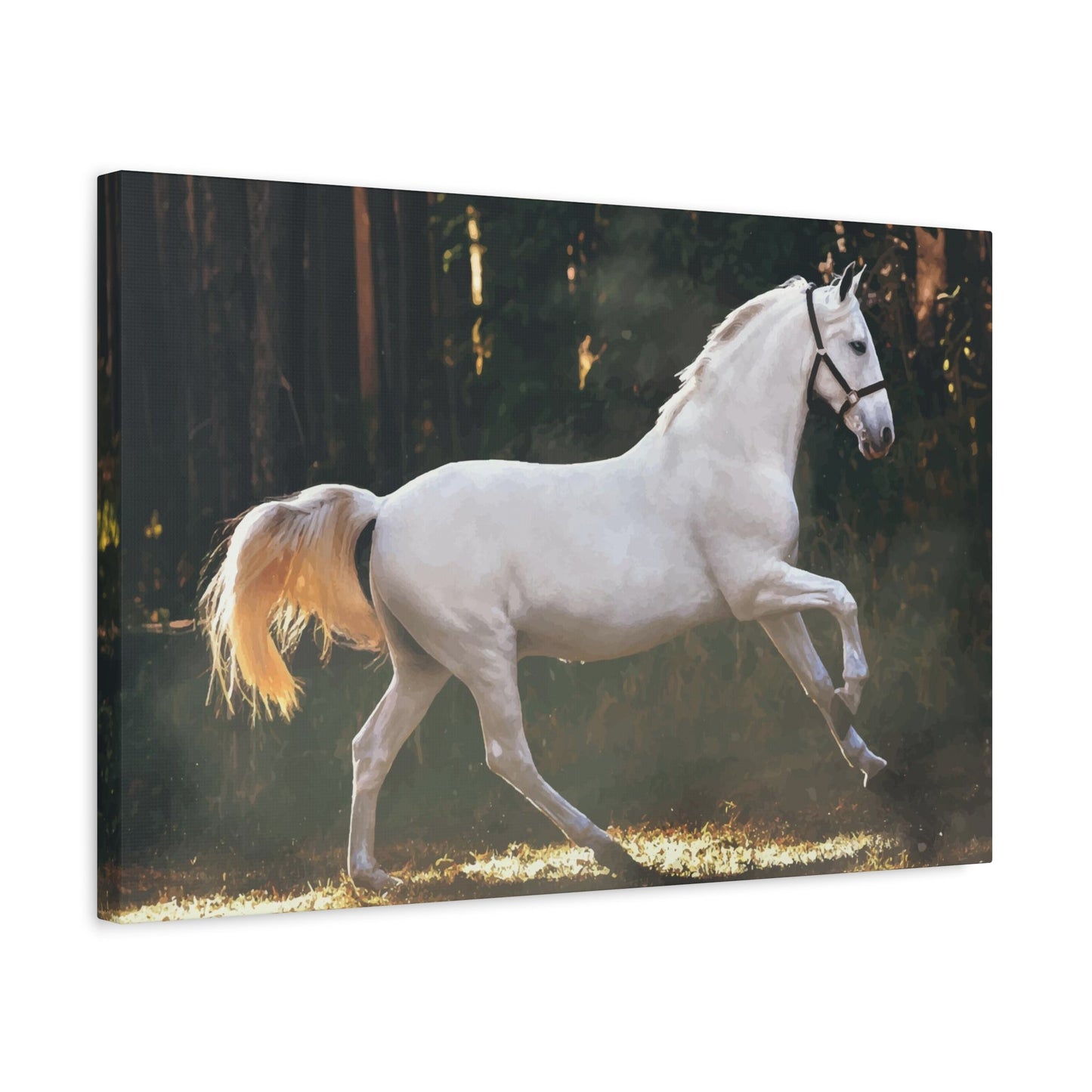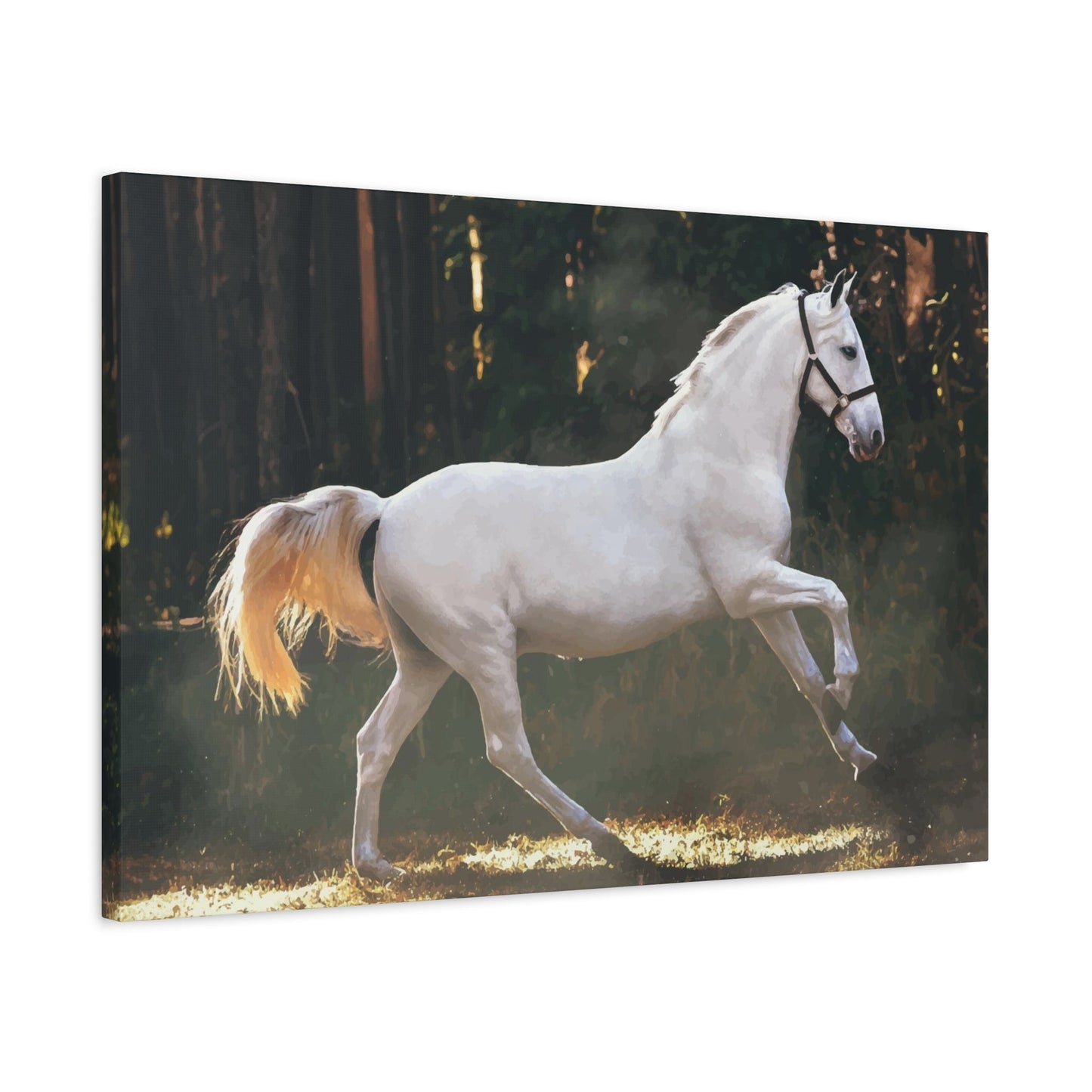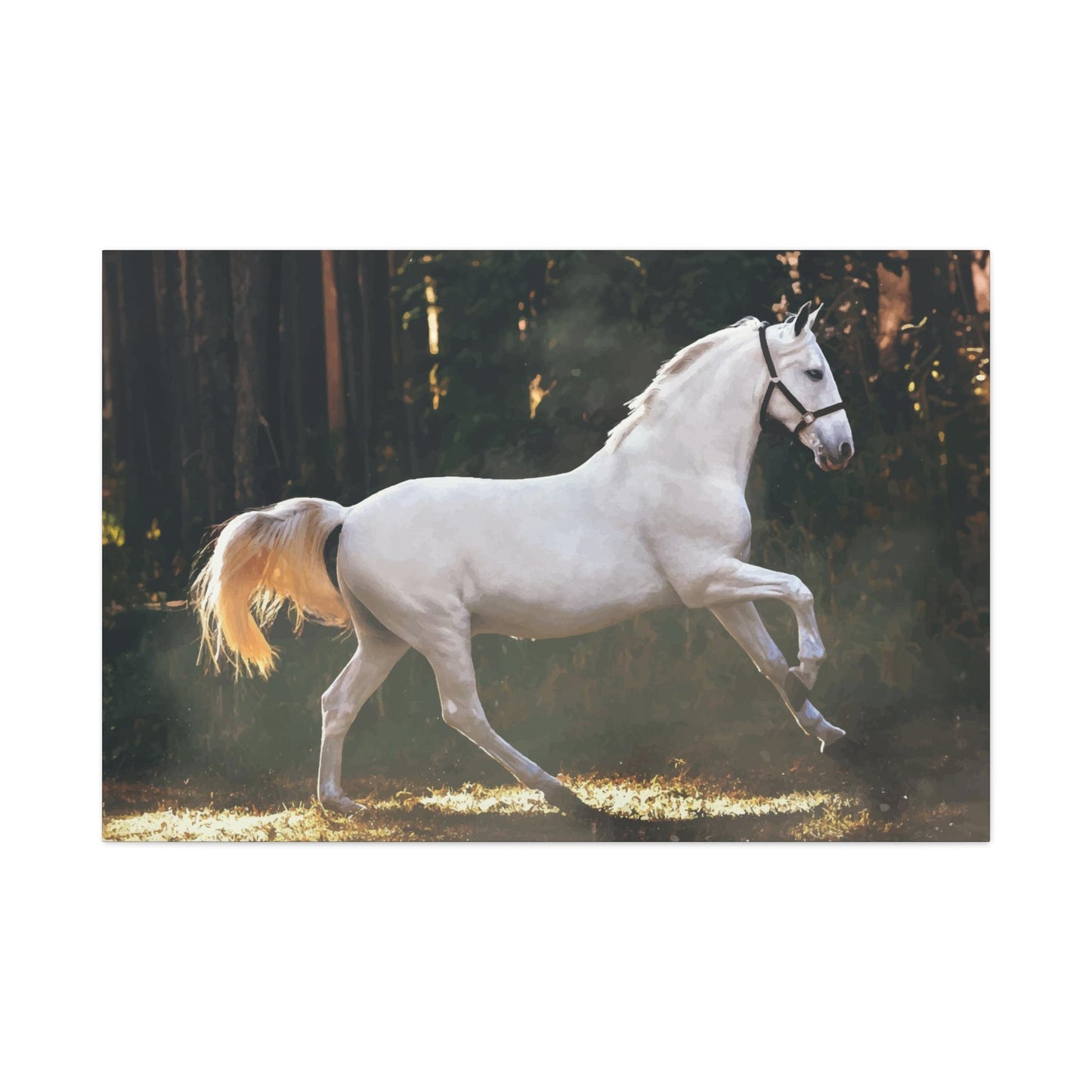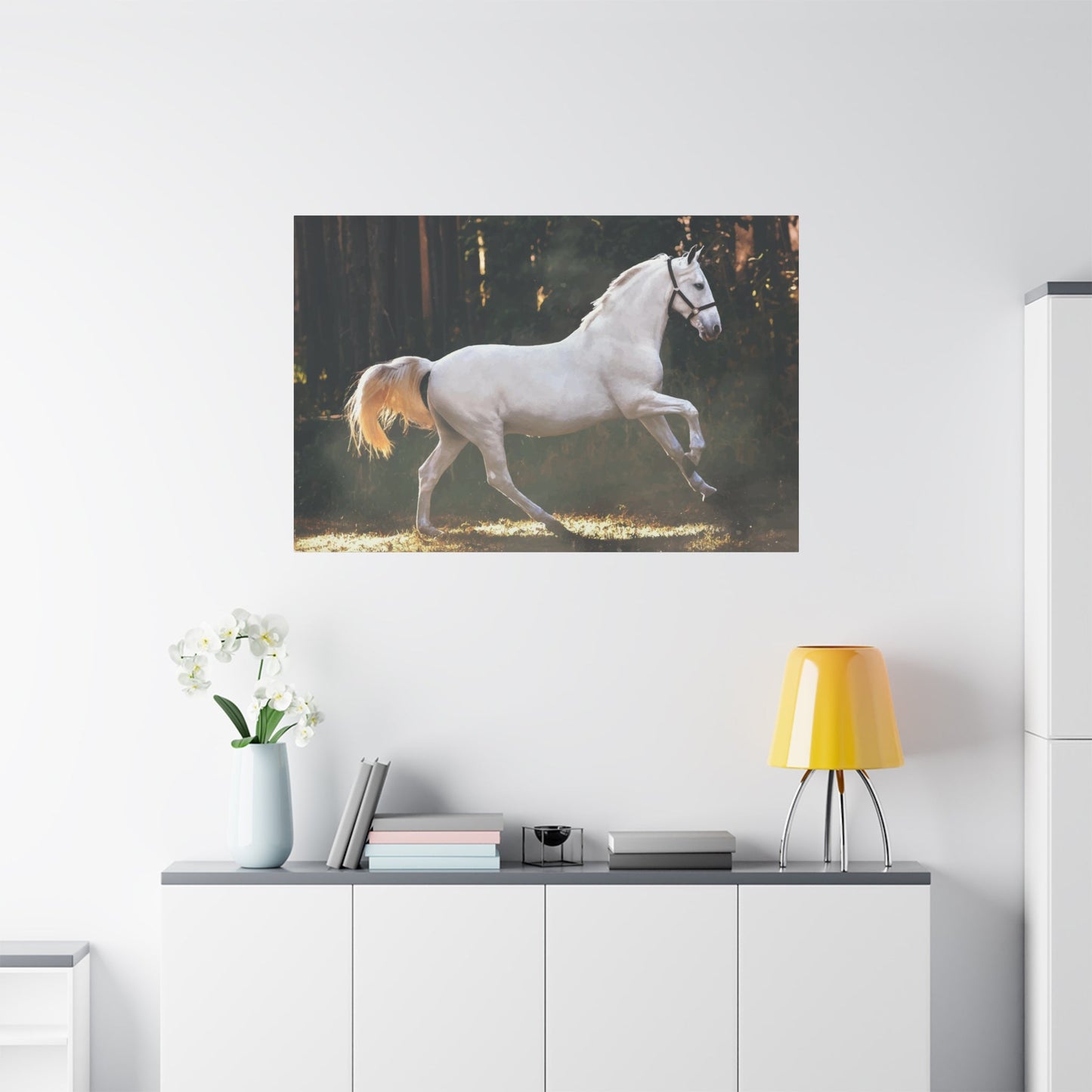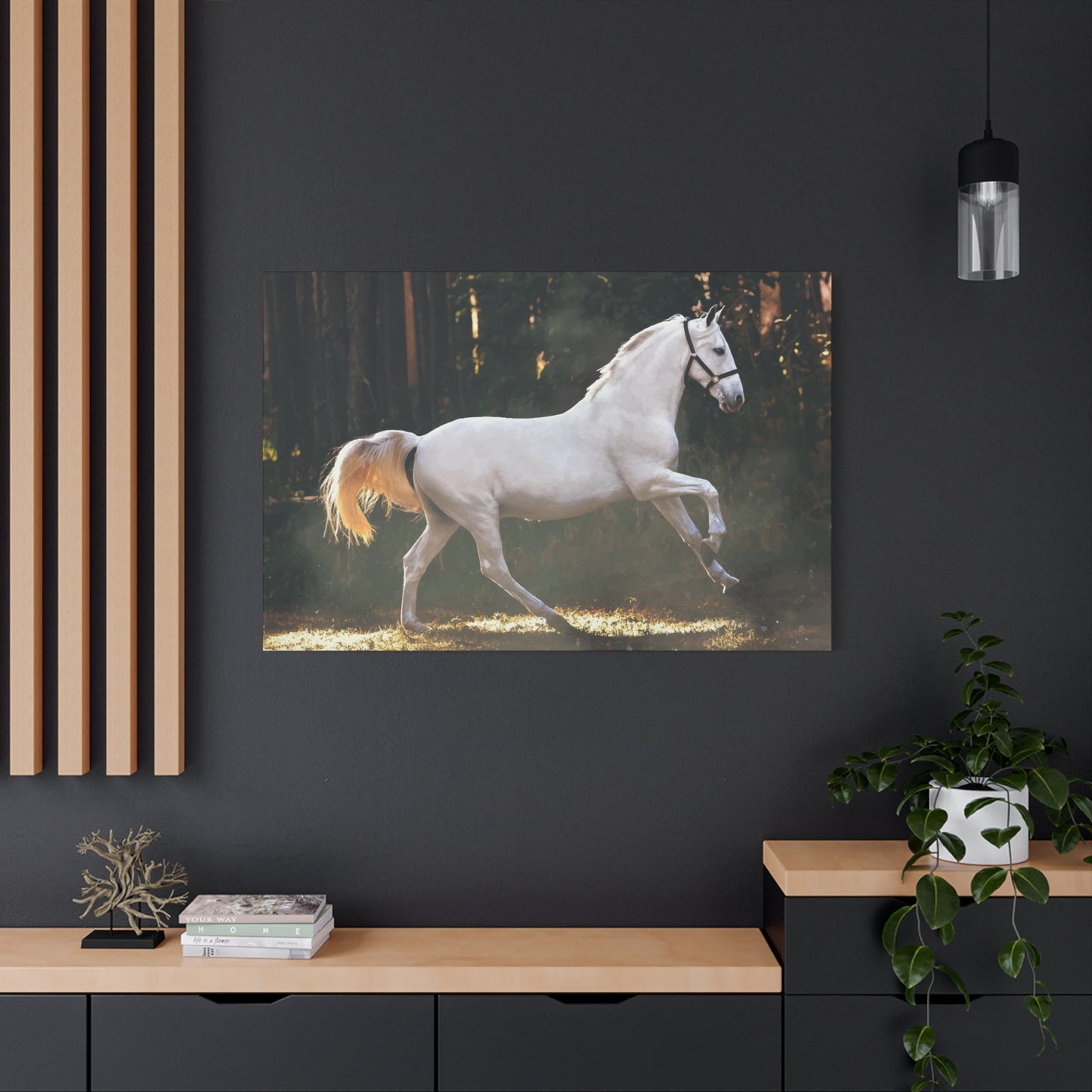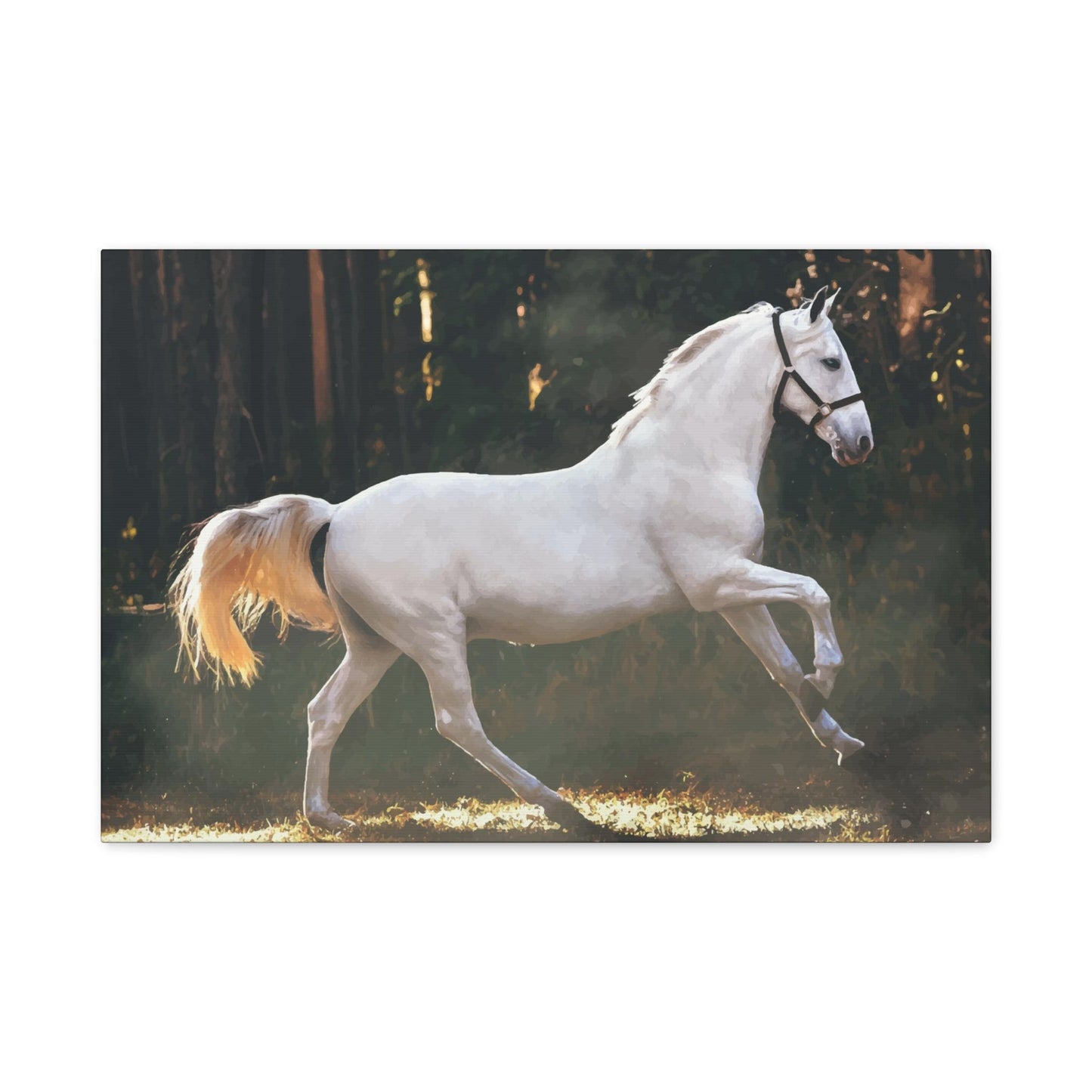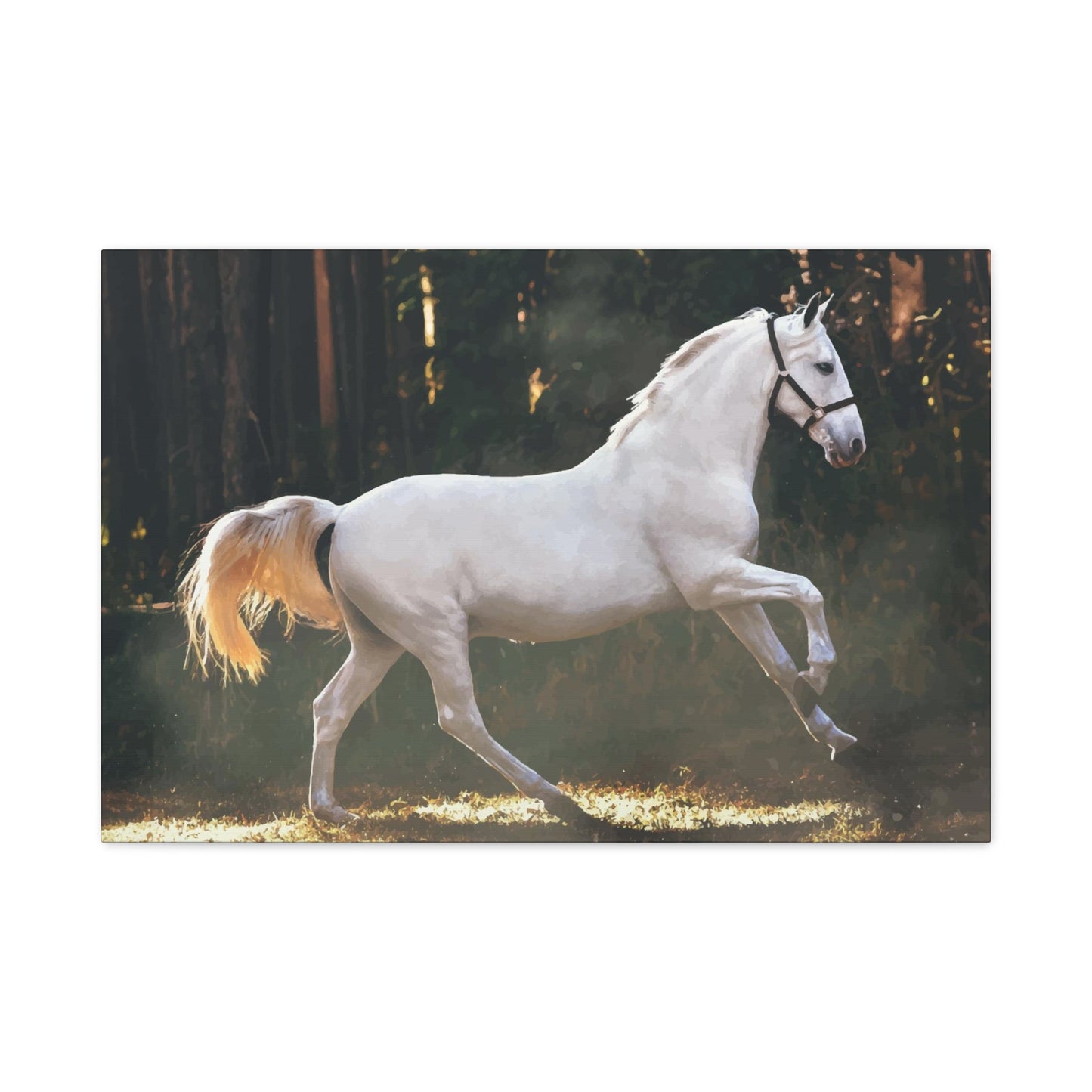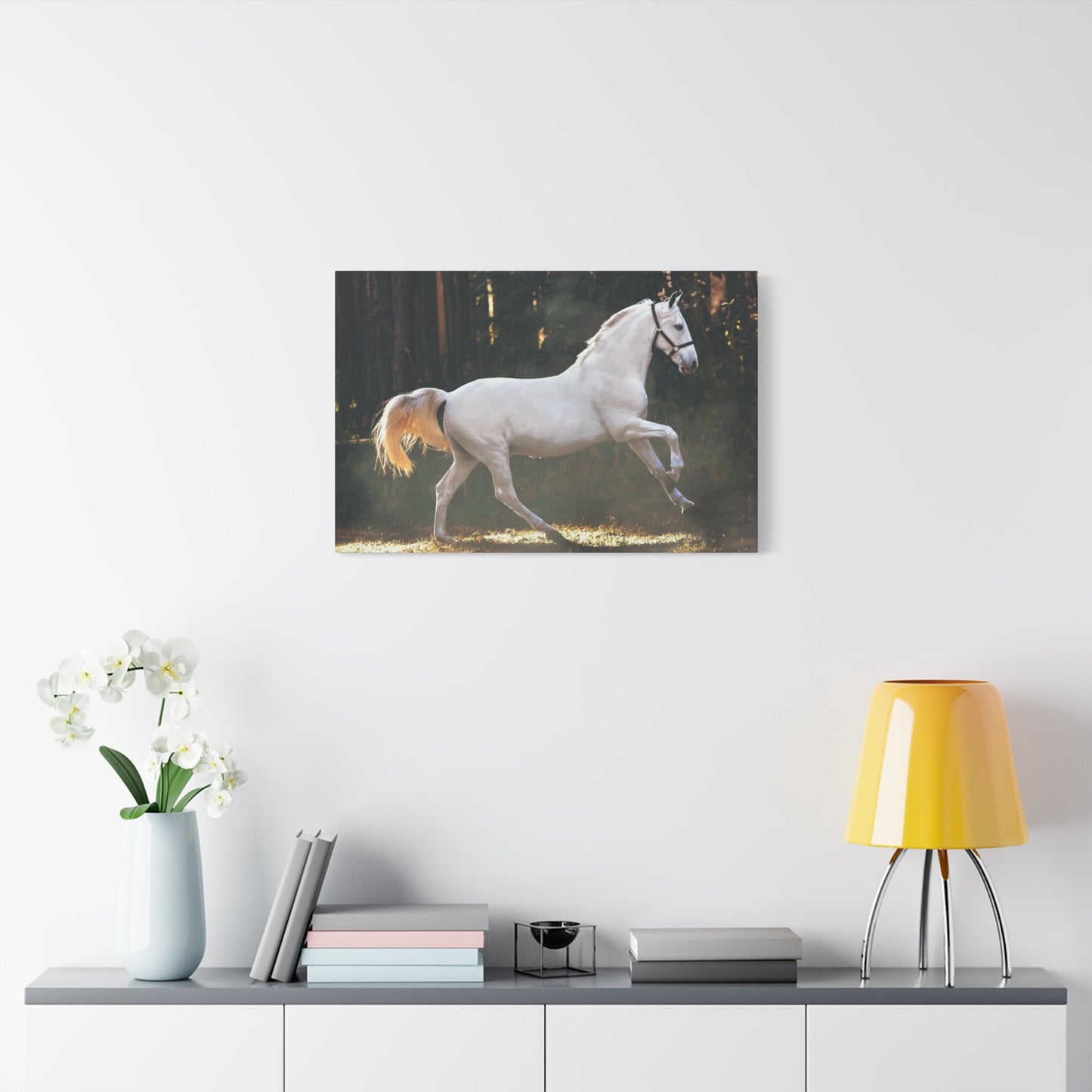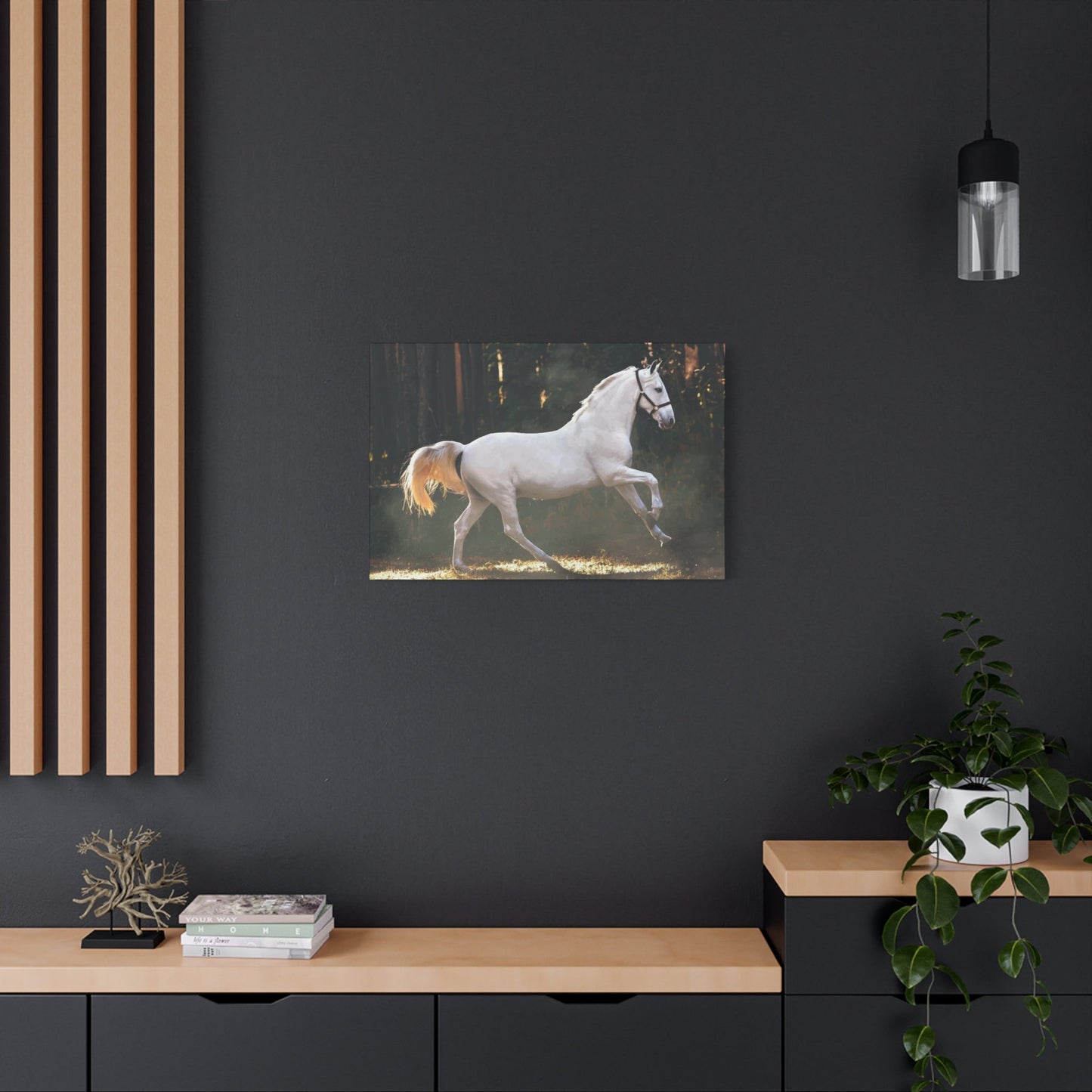Magnificent White Horse Wall Art Collection Ideas for Every Home
The timeless beauty of equine artwork has captivated homeowners and art enthusiasts for centuries. White horses, in particular, represent pure elegance and grace that can elevate any room's aesthetic appeal. These majestic creatures symbolize freedom, strength, and serenity, making them perfect subjects for home decoration. Whether you're drawn to realistic portrayals or abstract interpretations, incorporating horse-themed artwork into your living environment creates a sophisticated atmosphere that speaks to both comfort and style.
The growing popularity of equine-themed home decor reflects our deep connection with these noble animals. White horses hold special significance across cultures, often representing purity, nobility, and spiritual enlightenment. When translated into visual art, these meanings become powerful focal points that can transform ordinary rooms into extraordinary sanctuaries.
Modern homeowners are increasingly seeking artwork that not only beautifies their environment but also carries emotional resonance. Horse imagery accomplishes both objectives effortlessly, offering visual impact while connecting viewers to themes of freedom and natural beauty. The versatility of equine artwork allows it to complement various decorating styles, from contemporary minimalism to rustic farmhouse aesthetics.
The selection process for horse-themed artwork involves considering multiple factors including room size, existing color schemes, and personal preferences. Understanding these elements ensures that your chosen pieces will harmonize with your existing decor while creating the desired atmospheric effect. This comprehensive exploration will guide you through every aspect of incorporating these magnificent creatures into your home's visual narrative.
Stunning White Horse Wall Art Ideas
Creating memorable visual displays with equine artwork requires thoughtful consideration of composition, placement, and artistic style. The beauty of white horse imagery lies in its versatility and timeless appeal. These magnificent creatures can be portrayed in countless ways, from photorealistic paintings to stylized sculptures, each offering unique advantages for different decorating schemes.
Contemporary artists have embraced white horse subjects with innovative approaches that blend traditional techniques with modern sensibilities. Large-scale canvases featuring galloping horses create dramatic focal points, while smaller, intimate pieces add subtle elegance to personal settings. The key to successful implementation lies in understanding how different artistic interpretations can enhance your home's existing character.
Gallery walls featuring multiple horse-themed pieces allow for creative storytelling through visual art. Combining photographs, paintings, and mixed-media works creates dynamic displays that capture different aspects of equine beauty. The monochromatic nature of white horse subjects provides cohesive visual flow while allowing for varied artistic techniques and styles within the same collection.
Sculptural elements add three-dimensional interest to horse-themed displays. Bronze sculptures, ceramic figurines, and metal artwork introduce textural variety that complements traditional two-dimensional pieces. These elements work particularly well in transitional areas like hallways and entryways, where they can greet visitors with impressive visual impact.
Seasonal rotation of horse artwork keeps displays fresh and engaging throughout the year. Summer pieces might emphasize horses in natural outdoor settings, while winter selections could focus on more intimate, contemplative scenes. This approach allows homeowners to maintain visual interest while expressing different moods and themes as seasons change.
Mixed-media approaches combine photography, painting, and digital art techniques to create unique interpretative pieces. These contemporary works often blur the lines between reality and artistic expression, offering modern alternatives to traditional equine portraiture. Such pieces work exceptionally well in contemporary homes where innovation and creativity are valued design elements.
Color coordination within horse-themed collections creates visual harmony while allowing for individual piece variation. White horses naturally complement neutral color palettes, but they can also provide stunning contrast against bold, saturated backgrounds. Understanding color relationships helps ensure that your selections will work together cohesively rather than competing for attention.
Scale variation adds visual interest and prevents monotony in horse-themed displays. Combining oversized statement pieces with smaller accent works creates dynamic arrangements that guide the eye through different focal points. This technique works particularly well in large rooms where multiple viewing distances allow appreciation of both detailed work and broad compositional elements.
Lighting considerations play crucial roles in showcasing horse artwork effectively. Natural light enhances the luminous quality of white horse subjects, while strategic artificial lighting can create dramatic effects that transform the viewing experience. Understanding how different lighting conditions affect your chosen pieces ensures optimal presentation throughout various times of day.
Professional framing elevates even modest horse artwork to museum-quality presentation standards. Quality matting and frame selection can dramatically impact how pieces are perceived and appreciated. Investment in professional presentation often yields disproportionate returns in terms of overall visual impact and long-term satisfaction with your decorating choices.
How to Decorate with White Horse Art
Successfully incorporating equine artwork into existing decorating schemes requires strategic planning and careful consideration of existing elements. The process begins with honest assessment of your current decor, identifying areas where horse-themed pieces can enhance rather than overwhelm existing visual relationships. This foundational understanding prevents costly mistakes and ensures satisfying results.
Room function significantly influences artwork selection and placement decisions. Living areas benefit from larger, more dramatic pieces that can serve as conversation starters and focal points for social gatherings. Bedrooms require more intimate, calming selections that promote relaxation and peaceful rest. Understanding these functional requirements guides appropriate artistic choices for different environments.
Color harmony between horse artwork and existing furnishings creates cohesive visual flow throughout your home. White horses naturally complement neutral color schemes, making them excellent choices for contemporary and minimalist decorating approaches. However, they can also provide striking contrast in more colorful environments, serving as visual anchors that ground bolder decorating choices.
Furniture arrangement often requires adjustment to properly showcase new artwork additions. Seating areas should be positioned to allow comfortable viewing of featured pieces, while traffic patterns must remain unobstructed. Sometimes minor furniture repositioning can dramatically improve how artwork is experienced and appreciated within the room's overall composition.
Layering techniques create sophisticated displays that reflect personal taste and artistic sensibility. Combining horse artwork with complementary subjects like landscape photography or abstract paintings adds depth and interest to wall displays. The key lies in maintaining visual balance while allowing each piece to contribute to the overall narrative being created.
Textural elements surrounding horse artwork enhance the overall sensory experience of viewing these pieces. Natural materials like wood, stone, and leather complement equine subjects beautifully, reinforcing themes of natural beauty and outdoor life. These supporting elements should enhance rather than compete with the primary artwork for visual attention.
Seasonal adaptability allows horse-themed decorating to evolve throughout the year. Summer displays might emphasize outdoor scenes and active horses, while autumn selections could focus on more contemplative, indoor subjects. This flexibility keeps decorating fresh and prevents visual stagnation that can occur with permanent, unchanging displays.
Proportion relationships between artwork and surrounding architectural elements ensure harmonious integration within your home's existing structure. Tall, vertical pieces work well in rooms with high ceilings, while horizontal compositions suit spaces with lower ceiling heights. Understanding these relationships prevents artwork from appearing either oversized or insignificantly small within their intended environments.
Personal collection development allows for gradual expansion of horse-themed artwork over time. Starting with one or two key pieces and gradually adding complementary works creates opportunities for thoughtful curation rather than impulsive purchasing. This approach often results in more cohesive, personally meaningful collections that reflect genuine appreciation for equine subjects.
Investment considerations balance immediate decorating needs with long-term collecting goals. Original artwork typically appreciates in value over time, while high-quality reproductions provide affordable access to desirable images. Understanding these distinctions helps inform purchasing decisions that align with both budgetary constraints and aesthetic objectives.
White Horse Paintings for Calm Spaces
Creating tranquil environments through carefully selected artwork requires understanding how visual elements affect human psychology and emotional responses. White horse paintings possess inherent qualities that promote serenity and contemplation, making them ideal choices for areas designated for relaxation and rejuvenation. These powerful images can transform ordinary rooms into peaceful sanctuaries that support mental and emotional well-being.
The calming effect of equine imagery stems from multiple psychological associations with horses and their symbolic meanings. White horses, in particular, represent purity, peace, and spiritual transcendence across numerous cultural traditions. These positive associations create subconscious responses that promote relaxation and stress reduction when viewing such artwork in personal environments.
Soft, muted color palettes in horse paintings enhance their calming properties while maintaining visual interest and sophistication. Watercolor techniques often produce particularly soothing effects, with their gentle transitions and ethereal qualities that seem to breathe life into static images. These subtle artistic approaches work exceptionally well in bedrooms, meditation areas, and other spaces designated for quiet activities.
Composition elements within calming horse paintings should emphasize balance, harmony, and peaceful movement rather than dynamic action or dramatic tension. Images of horses grazing quietly, standing in contemplative poses, or moving gently through serene landscapes create the most effective calming influences. These subjects invite viewers to slow down and appreciate moments of natural tranquility.
Natural lighting considerations play crucial roles in maximizing the calming effects of horse paintings. Gentle, diffused light enhances the peaceful qualities of these images while avoiding harsh contrasts that might create visual stress. Positioning artwork to take advantage of natural light patterns throughout the day ensures optimal viewing conditions for relaxation and contemplation.
Size selection for calming horse paintings should complement rather than overwhelm the intended peaceful atmosphere. Medium-sized pieces often work best in relaxation areas, providing sufficient visual interest without creating overstimulating effects. The goal is to create gentle focal points that draw attention without demanding it, allowing viewers to engage with the artwork at their own comfortable pace.
Complementary decorating elements should reinforce rather than compete with the calming effects of horse paintings. Natural materials, soft textures, and neutral colors create supportive environments that enhance the peaceful qualities of equine artwork. Plants, natural fiber textiles, and wooden elements work particularly well in creating comprehensive calming environments.
Placement strategies for calming horse paintings consider viewing angles and distances that promote comfortable observation. Artwork positioned at comfortable eye level encourages natural engagement, while pieces placed too high or too low can create neck strain that counteracts intended calming effects. Thoughtful positioning ensures that the artwork can fulfill its intended purpose of promoting relaxation.
Multiple piece arrangements in calming environments should maintain visual harmony and prevent overwhelming effects. Series of smaller horse paintings can create gentle visual rhythm without disrupting peaceful atmospheres. The key lies in maintaining appropriate spacing and scale relationships that feel natural and unforced within the room's overall composition.
Maintenance considerations for calming horse paintings ensure their continued effectiveness in promoting peaceful environments. Regular dusting and appropriate climate control preserve artwork quality while preventing deterioration that might detract from their aesthetic appeal. Well-maintained pieces continue to provide calming benefits for years, making proper care worthwhile investments in personal well-being.
Choosing White Horse Art for Your Home
Selecting appropriate equine artwork for residential settings involves balancing personal preferences with practical considerations that ensure long-term satisfaction with your decorating investments. The decision-making process begins with honest assessment of your home's architectural characteristics, existing decorating style, and functional requirements for different room environments. This foundational understanding guides appropriate artistic choices that will enhance rather than conflict with your existing home environment.
Personal taste preferences play fundamental roles in artwork selection, but they should be balanced with objective considerations about how pieces will function within your home's overall aesthetic framework. Some homeowners gravitate toward realistic representations of horses, while others prefer stylized or abstract interpretations. Understanding your own preferences helps narrow the vast array of available options to manageable selections that reflect your individual aesthetic sensibilities.
Budget considerations significantly influence artwork selection processes, but quality options exist across all price ranges. Original paintings typically command higher prices than reproductions, but both categories offer opportunities for meaningful additions to home decor collections. Understanding the differences between original artwork, limited edition prints, and mass-produced reproductions helps inform purchasing decisions that align with both aesthetic goals and financial constraints.
Room-specific requirements influence appropriate artwork selection for different areas within your home. Living rooms typically accommodate larger, more dramatic pieces that can serve as conversation focal points, while bedrooms benefit from more intimate, calming selections. Kitchens and bathrooms require moisture-resistant materials and treatments, while hallways can showcase collections of smaller pieces that create visual interest in transitional areas.
Style compatibility ensures that new horse artwork will integrate successfully with existing decorating elements rather than creating visual conflicts. Contemporary homes might benefit from abstract or minimalist equine representations, while traditional settings could accommodate more classical realistic portrayals. Understanding your home's existing style characteristics guides appropriate artistic choices that will enhance overall decorating cohesion.
Color coordination between horse artwork and existing room elements prevents visual conflicts while creating harmonious decorating relationships. White horses naturally complement neutral color schemes, but they can also provide stunning contrast elements in more colorful environments. Analyzing your existing color palette helps identify artwork that will contribute positively to overall visual harmony rather than creating competitive relationships.
Quality assessment skills help ensure that your artwork investments will provide lasting satisfaction and value. Understanding differences between various printing techniques, paper qualities, and frame construction helps identify pieces that will maintain their appearance over time. Investment in higher-quality pieces often proves more economical in long-term perspective than repeatedly replacing inferior items.
Size considerations involve both physical dimensions and visual scale relationships within intended room environments. Measuring available wall areas and considering furniture placement prevents purchasing artwork that proves either too large or too small for effective presentation. Understanding scale relationships ensures that selected pieces will create appropriate visual impact without overwhelming or disappearing within their intended settings.
Authentication and provenance considerations become important when purchasing original artwork or limited edition pieces. Understanding artist credentials, edition sizes, and authenticity documentation protects your investment while ensuring that you receive genuine value for your expenditure. Reputable dealers provide appropriate documentation and stand behind the authenticity of pieces they sell.
Return and exchange policies provide important protection for artwork purchases, particularly when buying online or sight-unseen. Understanding seller policies regarding returns, exchanges, and condition guarantees helps protect your investment while providing flexibility if pieces don't meet expectations once viewed in your home environment. This protection is particularly important for significant financial investments in original artwork.
White Horse Wall Art in Minimalist Decor
Minimalist decorating philosophies emphasize simplicity, functionality, and carefully curated visual elements that serve multiple purposes within clean, uncluttered environments. White horse artwork aligns perfectly with these principles, offering powerful visual impact while maintaining the understated elegance that characterizes successful minimalist design approaches. The monochromatic nature of white horse subjects complements neutral color palettes typically favored in minimalist settings.
Clean lines and simple compositions in horse artwork enhance minimalist aesthetics while avoiding the visual complexity that can overwhelm carefully controlled environments. Photographs of white horses often work particularly well in minimalist settings, offering realistic beauty without the textural complexity of painted surfaces. The crisp definition and precise detail of photographic images complement the precision and intentionality that define minimalist decorating approaches.
Negative space utilization becomes particularly important when incorporating artwork into minimalist environments. White horse images often feature significant areas of negative space that complement the uncluttered aesthetic of minimalist rooms. These compositional elements allow artwork to breathe within their environments rather than competing with other design elements for visual attention.
Quality over quantity principles guide artwork selection in minimalist environments, where fewer, more impactful pieces create stronger visual statements than numerous smaller items. A single, well-chosen white horse image can serve as a room's primary focal point, eliminating the need for additional decorative elements that might compromise the clean aesthetic that minimalist design seeks to achieve.
Monochromatic color schemes in minimalist settings provide perfect backdrops for white horse artwork, allowing the natural beauty of equine subjects to shine without color competition. Black and white photography of horses works particularly well in these environments, offering sophisticated visual interest while maintaining color restraint that supports overall design goals.
Geometric framing and presentation elements complement minimalist aesthetics while properly showcasing horse artwork. Simple, clean-lined frames in neutral colors provide appropriate borders without adding visual complexity that might compromise minimalist design objectives. Metal frames, particularly in brushed aluminum or black finishes, often work exceptionally well in contemporary minimalist settings.
Lighting design in minimalist environments should enhance horse artwork presentation while maintaining the clean, uncluttered appearance that characterizes this decorating approach. Track lighting systems or recessed fixtures provide focused illumination without adding visual complexity through decorative lighting fixtures. The goal is to illuminate artwork effectively while keeping lighting elements as inconspicuous as possible.
Material selection for horse artwork in minimalist settings should emphasize quality and durability over decorative complexity. Canvas prints, metal prints, and high-quality photographic papers provide appropriate foundations for horse images while maintaining the material honesty that minimalist design values. These materials age well and maintain their appearance with minimal maintenance requirements.
Placement strategies in minimalist environments emphasize purposeful positioning that creates visual balance without cluttering. Single statement pieces work better than groupings in most minimalist settings, allowing each artwork selection to receive appropriate attention and appreciation. The goal is to create intentional focal points rather than busy visual displays.
Seasonal adaptability in minimalist horse artwork collections allows for subtle environmental changes without compromising design principles. Rotating between different horse images throughout the year maintains visual freshness while respecting the minimalist preference for controlled, intentional design changes. This approach prevents visual stagnation while maintaining decorating discipline.
Symbolism of White Horses in Art
Throughout human history, white horses have carried profound symbolic meanings that transcend cultural boundaries and speak to universal human experiences and aspirations. These majestic creatures appear in mythologies, religious traditions, and artistic expressions across diverse civilizations, consistently representing themes of purity, nobility, spiritual enlightenment, and divine connection. Understanding these symbolic associations adds depth and meaning to horse artwork selection and appreciation.
In Western traditions, white horses often symbolize heroism, nobility, and righteous triumph over adversity. Medieval legends frequently featured white steeds carrying knights on noble quests, while fairy tales portrayed them as magical creatures capable of transcending ordinary limitations. These cultural associations continue to resonate in contemporary art, where white horses often represent aspiration, achievement, and the pursuit of higher ideals.
Eastern philosophies and artistic traditions attribute different but equally powerful meanings to white horses. In Chinese culture, white horses symbolize longevity, wisdom, and spiritual transformation. Buddhist traditions often depict enlightened beings riding white horses, representing the journey from ignorance to wisdom. These spiritual associations make white horse artwork particularly meaningful in meditation areas and contemplative environments.
Psychological interpretations of white horse symbolism connect these images to concepts of freedom, wildness, and the untamed aspects of human nature. Jungian analysis suggests that horses represent instinctual wisdom and the connection between conscious and unconscious minds. White horses, in particular, may symbolize purified instinct or the integration of primitive and civilized aspects of human experience.
Contemporary artistic interpretations of white horse symbolism often explore themes of environmental conservation and humanity's relationship with the natural world. Modern artists may use white horse imagery to represent endangered wildness or the need to preserve natural beauty in increasingly urbanized environments. These contemporary meanings add relevance and urgency to traditional symbolic associations.
Gender symbolism associated with white horses varies across cultures but often emphasizes feminine qualities of grace, intuition, and nurturing power. The connection between horses and lunar symbolism reinforces these feminine associations, making white horse artwork particularly resonant in environments designed to honor feminine energy and wisdom. This symbolism influences artwork selection for personal and sacred environments.
Spiritual transformation themes frequently appear in white horse artwork, reflecting ancient beliefs about these animals' ability to carry souls between different realms of existence. Renaissance paintings often depicted saints and religious figures with white horses, symbolizing their role as spiritual guides and mediators between earthly and divine realms. These associations continue to influence contemporary spiritual and religious artistic expressions.
Power and strength symbolism inherent in horse imagery combines with purity associations of white coloration to create complex symbolic meanings. White horses represent strength tempered by wisdom, power guided by moral purpose, and physical capability elevated by spiritual awareness. These multilayered meanings make white horse artwork appropriate for environments where inspiration and motivation are desired.
Cultural preservation aspects of white horse symbolism connect contemporary artwork to ancient traditions and timeless human values. Displaying white horse imagery can serve as a bridge between past and present, honoring traditional wisdom while expressing contemporary aesthetic sensibilities. This temporal connection adds historical depth to modern decorating choices.
Healing and therapeutic associations with white horse symbolism make such artwork particularly appropriate for healthcare environments and personal healing sanctuaries. The calming, hopeful qualities traditionally associated with white horses can contribute to environments designed to promote physical, emotional, and spiritual recovery. These therapeutic applications extend the value of white horse artwork beyond mere decoration.
Best Materials for White Horse Wall Art
The selection of appropriate materials for horse artwork significantly impacts both aesthetic appeal and long-term durability, making material considerations crucial factors in the artwork acquisition process. Different materials offer unique advantages and characteristics that suit various decorating styles, environmental conditions, and budget requirements. Understanding these material properties helps ensure that your horse artwork investments will provide lasting beauty and satisfaction.
Canvas materials provide traditional foundations for horse artwork that offer excellent color reproduction and artistic authenticity. Stretched canvas creates slight texture that adds visual interest and depth to horse images, while canvas prints can reproduce the appearance of original paintings at more accessible price points. High-quality canvas materials resist fading and maintain their appearance for decades when properly cared for and protected from direct sunlight.
Metal prints represent contemporary approaches to horse artwork presentation that offer exceptional durability and unique aesthetic qualities. Aluminum and steel substrates create luminous, almost three-dimensional appearances that particularly enhance the ethereal qualities of white horse imagery. These materials resist moisture, fading, and physical damage while providing contemporary aesthetic appeal that complements modern decorating styles.
Photographic papers designed for fine art applications offer superior color accuracy and longevity for horse photography and photographic reproductions. Archival papers treated with protective coatings maintain their appearance for generations when displayed under appropriate conditions. Different paper textures, from smooth glossy surfaces to textured matte finishes, create varying aesthetic effects that suit different artistic visions and decorating requirements.
Wood substrates provide rustic, natural foundations for horse artwork that complement farmhouse, cabin, and outdoor-themed decorating styles. Cedar, pine, and reclaimed wood panels offer unique character through natural grain patterns and coloration that enhance the organic appeal of equine subjects. These materials work particularly well for casual, country-inspired environments where natural materials are emphasized.
Acrylic mounting systems create sleek, contemporary presentations that seem to suspend horse images in transparent materials. These mounting techniques produce striking visual effects while protecting artwork from environmental damage. Acrylic presentations work exceptionally well in modern settings where clean, minimal aesthetic approaches are desired.
Glass materials used in framing and presentation protect artwork while providing clear viewing surfaces that don't interfere with color accuracy or visual clarity. Museum-quality glass includes UV protection that prevents fading while anti-reflective coatings improve viewing under various lighting conditions. These protective materials represent worthwhile investments for valuable artwork pieces.
Textile materials, including embroidered and woven interpretations of horse subjects, add textural variety to artwork collections while introducing handcrafted elements that complement rustic and traditional decorating styles. Tapestries, quilts, and embroidered panels offer unique artistic interpretations that differ from traditional painting and photography approaches.
Ceramic and pottery materials provide three-dimensional alternatives to traditional flat artwork while maintaining artistic subject matter focused on horses. Sculptural ceramics, decorative tiles, and pottery reliefs introduce textural variety and dimensional interest that complement two-dimensional artwork displays. These materials work particularly well in kitchens, bathrooms, and outdoor areas where moisture resistance is important.
Mixed media approaches combine multiple materials within single artistic pieces, creating unique interpretations that blend traditional and contemporary techniques. Combinations of photography, painting, and sculptural elements produce one-of-a-kind pieces that serve as conversation starters and artistic focal points. These innovative materials suit contemporary homes where creativity and uniqueness are valued.
Sustainability considerations in material selection reflect growing environmental awareness and commitment to responsible consumption practices. Reclaimed materials, sustainably harvested woods, and eco-friendly printing processes allow horse artwork appreciation while supporting environmental conservation goals. These choices align artwork acquisition with broader lifestyle values and environmental commitments.
Where to Buy White Horse Prints
Locating high-quality horse artwork requires understanding the various marketplace options available to contemporary consumers, each offering distinct advantages in terms of selection, pricing, authentication, and customer service. The artwork acquisition landscape includes traditional galleries, online marketplaces, artist studios, and specialty retailers, each serving different customer needs and preferences. Successful artwork shopping involves matching your specific requirements with appropriate marketplace options.
Local art galleries provide opportunities to view horse artwork in person before purchasing, allowing assessment of quality, color accuracy, and scale relationships that online shopping cannot replicate. Gallery relationships often include curatorial expertise and authentication services that protect buyers from inferior or misrepresented pieces. Many galleries also offer custom framing services and installation assistance that simplify the artwork acquisition process.
Online marketplaces offer unprecedented access to global horse artwork selections while providing convenient shopping experiences and competitive pricing. Reputable online art retailers provide detailed images, accurate descriptions, and customer reviews that help inform purchasing decisions. However, online shopping requires careful attention to return policies, shipping procedures, and authentication guarantees to protect your investment.
Artist studios and individual artists provide direct access to original works and custom commissions that create unique, personalized artwork solutions. Working directly with artists often results in more affordable pricing while supporting creative professionals directly. Commission work allows for customization of size, color, and compositional elements that perfectly suit your specific decorating requirements.
Art fairs and outdoor markets provide opportunities to discover emerging artists and unique pieces while enjoying social shopping experiences. These venues often feature competitive pricing and direct artist interaction that adds personal connection to artwork acquisition. However, authentication and return protections may be limited, requiring careful evaluation before purchasing.
Museum shops and cultural institutions offer carefully curated selections of horse artwork reproductions and related items that provide access to famous works at reasonable prices. These sources typically ensure quality and authenticity while supporting cultural institutions through your purchases. Limited selection may require patience or compromise in finding specific pieces that match your requirements.
Specialty equestrian retailers focus specifically on horse-related artwork and decorative items, providing extensive selections and knowledgeable customer service from staff who understand equine subjects. These retailers often carry exclusive pieces and limited editions that may not be available through general art marketplaces. Specialized knowledge can help guide appropriate selections for specific decorating objectives.
Interior design services provide professional assistance in artwork selection and placement, often including access to trade-only sources and professional discounts. Design professionals can coordinate artwork selection with overall decorating schemes while handling installation and styling details. These services prove particularly valuable for comprehensive decorating projects or when expertise in color and scale relationships is needed.
Auction houses and estate sales occasionally offer valuable horse artwork at competitive prices, though success requires patience and knowledge to identify quality pieces among variable selections. These venues can provide access to original works and vintage pieces that carry historical significance and investment potential. However, authentication and condition assessment skills become crucial for successful bidding.
Print-on-demand services allow access to vast libraries of horse imagery with customization options for size, materials, and framing. These services provide cost-effective solutions for decorating multiple rooms or creating coordinated displays. Quality varies among providers, making research and sample evaluation important steps in the selection process.
White Horse Art for Bedroom Walls
Creating peaceful, restful bedroom environments through carefully selected horse artwork requires understanding how visual elements affect sleep quality, relaxation responses, and personal comfort levels. Bedrooms serve as private sanctuaries where residents retreat for rest and renewal, making artwork selection particularly important for supporting these essential functions. White horse imagery offers ideal subjects for bedroom decoration, combining visual beauty with calming psychological associations.
Scale considerations for bedroom horse artwork should emphasize intimate, personal sizing rather than dramatic, overwhelming presentations. Medium to small-scale pieces create appropriate visual interest without overstimulating environments designed for rest and relaxation. The goal is to provide gentle focal points that enhance rather than dominate bedroom atmospheres.
Placement strategies for bedroom horse artwork consider viewing angles from bed positions, ensuring comfortable appreciation without creating visual strain. Artwork positioned opposite bed footboards provides natural viewing opportunities without requiring neck strain or uncomfortable positioning. Avoid placing stimulating or energetic horse images directly above beds, where they might interfere with relaxation and sleep preparation.
Color palettes in bedroom horse artwork should emphasize soft, muted tones that promote tranquility and peaceful mental states. Watercolor interpretations of white horses often work exceptionally well in bedroom settings, offering ethereal beauty that doesn't overstimulate visual senses. Earth tones, soft blues, and gentle greens complement white horse subjects while maintaining calming environmental effects.
Lighting considerations for bedroom horse artwork should accommodate both natural and artificial illumination patterns throughout different times of day. Artwork should be visible and appreciable under soft evening lighting while not creating glare or harsh contrasts that might interfere with sleep preparation routines. Consider how morning light will interact with chosen pieces to ensure pleasant wake-up visual experiences.
Personal meaning and emotional connection become particularly important in bedroom artwork selection, where residents spend significant private time with chosen images. Horse artwork that resonates with personal memories, aspirations, or spiritual beliefs creates more satisfying decorating outcomes than pieces selected purely for aesthetic appeal. These personal connections enhance the bedroom's role as a private sanctuary.
Complementary decorating elements in horse-themed bedrooms should reinforce calming, natural themes while maintaining sophisticated aesthetic appeal. Natural fiber textiles, wooden furniture, and plant elements create supportive environments that enhance the organic beauty of horse subjects. Avoid overcrowding bedrooms with too many decorative elements that might compromise restful atmospheres.
Seasonal adaptability allows bedroom horse artwork to evolve with changing preferences and moods throughout the year. Summer selections might emphasize outdoor horse scenes, while winter choices could focus on more intimate, contemplative subjects. This flexibility prevents visual stagnation while maintaining appropriate seasonal connections to natural cycles.
Privacy considerations in bedroom horse artwork selection should respect the personal, intimate nature of these private areas. Avoid artwork that feels too public or performance-oriented in favor of pieces that support introspection and personal reflection. The goal is to create environments that feel safe, comfortable, and personally meaningful.
Maintenance accessibility ensures that bedroom horse artwork can be properly cared for without disrupting daily routines or bedroom functionality. Consider placement heights and locations that allow for regular dusting and cleaning without requiring furniture movement or inconvenient positioning. Well-maintained artwork continues to provide aesthetic pleasure without becoming maintenance burdens.
Mixing White Horse Art with Nature Themes
Combining equine artwork with broader nature themes creates cohesive decorating narratives that celebrate the beauty and diversity of the natural world. White horses, as natural subjects themselves, integrate seamlessly with landscape photography, botanical prints, and other wildlife imagery to create comprehensive environmental storytelling through visual art. This approach allows homeowners to create sophisticated displays that reflect appreciation for natural beauty and outdoor life.
Landscape integration techniques position horse artwork within broader environmental contexts, showing these magnificent creatures in their natural habitats. Combining individual horse portraits with landscape scenes creates visual narratives that tell stories about freedom, wildness, and the relationship between animals and their environments. These combinations work particularly well in living areas where conversation and storytelling are valued activities.
Botanical combinations pair horse imagery with plant and flower subjects to create gardens of visual beauty that bring outdoor freshness into indoor environments. White horses complement floral subjects beautifully, with their pure coloration providing neutral backdrops that allow colorful blooms to shine while maintaining visual harmony. These combinations work exceptionally well in dining rooms and kitchen areas where natural freshness is desired.
Wildlife photography collections can include white horse imagery alongside other animal subjects to create comprehensive celebrations of animal beauty and diversity. Combining horses with birds, deer, and other wild creatures creates educational displays that highlight the richness of natural life. These collections work well in family areas where children can appreciate and learn about different animal species.
Seasonal nature themes allow horse artwork to participate in evolving decorating schemes that change throughout the year. Spring displays might emphasize young horses in flower-filled meadows, while autumn selections could focus on horses against colorful foliage backgrounds. This seasonal rotation keeps decorating fresh while maintaining thematic consistency.
Water element combinations pair horse imagery with ocean, lake, and river scenes to create cooling, refreshing environmental themes. White horses running through surf or drinking from mountain streams create dynamic imagery that brings the sound and movement of water into static environments. These combinations work particularly well in bathrooms and areas where cooling effects are desired.
Mountain and wilderness themes position horse artwork within rugged, adventurous contexts that celebrate outdoor exploration and natural grandeur. Combining horse subjects with mountain landscape photography creates aspirational imagery that inspires adventure and outdoor activity. These combinations suit homes where outdoor recreation and adventure are important lifestyle elements.
Garden theme integration allows horse artwork to participate in cultivated natural beauty that bridges wild and domestic environmental expressions. Horses in formal garden settings or pastoral meadows create sophisticated imagery that appeals to gardening enthusiasts while maintaining artistic sophistication. These themes work well in sunrooms and areas with garden views.
Conservation messaging through combined nature and horse imagery can express environmental values and commitment to preservation of natural habitats. Artwork selections that emphasize unspoiled wilderness and wild horse populations create subtle environmental advocacy while maintaining decorating beauty. These choices align home decoration with broader environmental consciousness.
Texture variety in nature-themed horse displays prevents monotony while maintaining thematic coherence. Combining smooth photographic prints with textured canvas paintings and dimensional sculptural elements creates rich, engaging displays that invite closer examination. Different textures represent various aspects of natural beauty while maintaining visual unity through subject matter consistency.
White Horse Wall Art for Living Rooms
Living room environments present unique opportunities for horse artwork display, serving as primary gathering areas where residents and guests spend significant social time together. These rooms typically accommodate larger, more dramatic artwork that can serve as conversation focal points while reflecting homeowner personality and aesthetic preferences. White horse subjects offer timeless appeal that suits various decorating styles while maintaining broad guest appeal.
Scale opportunities in living rooms allow for statement-sized horse artwork that creates dramatic visual impact and serves as room focal points. Large canvas paintings or photograph prints of white horses can anchor entire room designs while providing conversation starters for social gatherings. The generous wall areas typical of living rooms accommodate oversized pieces that would overwhelm smaller, more intimate room settings.
Seating arrangement considerations ensure that horse artwork can be comfortably viewed and appreciated from multiple positions within living room layouts. Primary seating areas should offer clear sightlines to featured horse pieces, while secondary seating positions can provide alternative viewing angles that reveal different aspects of the artwork. This multi-position viewing capability maximizes artwork appreciation during social gatherings.
Lighting design in living rooms should accommodate both natural daylight viewing and artificial evening illumination of horse artwork. Track lighting systems or picture lights can provide focused illumination that highlights artwork during evening entertaining, while window treatments should control harsh daylight that might cause fading or glare. Flexible lighting systems allow optimal viewing conditions throughout different times of day and social activities.
Color coordination between horse artwork and living room furnishings creates cohesive design schemes that feel intentional and professionally planned. White horses naturally complement neutral furniture colors while providing opportunities for accent color introduction through mats, frames, or surrounding decorative elements. This neutral foundation allows for easy decorating updates without requiring artwork replacement.
Entertainment compatibility ensures that horse artwork enhances rather than competes with living room entertainment systems and technology. Artwork placement should avoid positions where television glare or speaker placement might interfere with proper appreciation. Consider how artwork will appear during both active entertainment use and quiet social conversation periods.
Traffic flow considerations prevent artwork placement in areas where foot traffic might cause damage while ensuring that pieces remain visible and accessible for appreciation. Living rooms typically experience more activity than other home areas, making durability and protection important factors in both artwork selection and placement decisions.
Seasonal entertaining adaptability allows horse artwork to support different types of social gatherings throughout the year. Formal entertaining might benefit from more sophisticated, elegant horse presentations, while casual family gatherings could accommodate more relaxed, playful interpretations. Flexible artwork arrangements support varying social functions and entertaining styles.
Guest appeal considerations recognize that living room artwork will be viewed by diverse audiences with varying aesthetic preferences and cultural backgrounds. White horses generally offer broad appeal across different demographic groups while avoiding potentially controversial subject matter. This universal appeal makes horse subjects safe choices for primary social areas.
Investment visibility in living rooms justifies higher-quality artwork purchases since these pieces will receive maximum viewing time and guest attention. The prominent display opportunities available in living rooms make them appropriate locations for original artwork or higher-end reproduction pieces that demonstrate aesthetic sophistication and cultural appreciation.
Abstract vs. Realistic White Horse Art
The artistic interpretation spectrum for white horse subjects ranges from photorealistic representations to highly abstract expressions, each offering distinct aesthetic advantages and appealing to different decorating sensibilities. Understanding the characteristics and applications of various artistic approaches helps homeowners select horse artwork that aligns with their personal preferences while complementing their existing decorating styles and environmental requirements.
Realistic horse artwork emphasizes accurate anatomical representation and natural coloration that celebrates the authentic beauty of these magnificent creatures. Photographic approaches capture precise detail and natural lighting that can transport viewers into natural environments where horses live and thrive. These realistic interpretations appeal to viewers who appreciate accuracy and natural beauty while providing educational value about equine anatomy and behavior.
Conclusion
The Magnificent White Horse Wall Art Collection captures a powerful blend of grace, freedom, and timeless beauty—making it a stunning choice for any home interior. With their majestic presence and symbolic strength, white horses have long been admired in art, and this collection transforms that admiration into a visual experience that resonates in every room. Whether your style leans rustic, modern, traditional, or eclectic, this collection offers versatile options that enhance your home with elegance and emotional depth.
At the heart of this collection is the white horse itself—an enduring symbol of purity, strength, and nobility. Each artwork showcases the animal in various dynamic poses: galloping across open fields, standing with quiet dignity, or emerging from abstract backgrounds. These visual narratives bring movement and emotion into your space, creating a powerful focal point that draws attention and admiration.
One of the most compelling aspects of this collection is its versatility. The white horse motif works beautifully in a wide range of spaces—living rooms, bedrooms, home offices, entryways, and even dining areas. In a minimalist setting, a bold white horse portrait against a neutral wall creates a striking statement. In farmhouse or rustic interiors, more textured or vintage-inspired horse artwork adds warmth and a touch of countryside charm. For modern homes, black-and-white or metallic-accented pieces bring a sleek and artistic edge.
Moreover, the Magnificent White Horse Collection isn't limited to one artistic style. From hyper-realistic paintings to abstract interpretations and photographic prints, the variety allows homeowners to choose pieces that align with their personal aesthetic. Whether you prefer canvas, framed prints, or mixed-media art, there’s a design within this collection that fits both your style and space.
Beyond its visual appeal, this wall art collection also brings a sense of emotional connection and inspiration. The image of a white horse often stirs feelings of courage, freedom, and resilience—qualities that many seek to surround themselves with in their everyday environments. It’s not just art for the wall; it’s a meaningful expression of inner values and aspirations.
In summary, the Magnificent White Horse Wall Art Collection is more than a decorative choice—it’s a celebration of strength, beauty, and spirit. With options that suit every home, style, and personality, these pieces provide more than visual interest—they tell a story, evoke emotion, and elevate any interior with a sense of timeless elegance. Whether you’re redesigning a room or looking for the perfect statement piece, this collection is a galloping step toward creating a space that is both inspiring and unforgettable.













